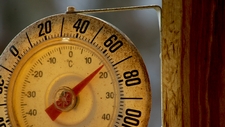Collecting Weather Information

TEKS Objective
The student is expected to record weather information, including relative temperature, such as hot or cold, clear or cloudy, calm or windy, and rainy or icy.
Essential Understanding
The student knows that the natural world includes the air around us and objects in the sky.
Science Background
Exploring Weather (website) - Information about different types of weather, from hurricanes to winter storms, as well as weather forecasting. Click on Weather WizKids for even more information.
Signature Lesson
Weather Experiments: Weather WizKids (website) - Students explore weather conditions and concepts (i.e., rain, clouds, wind direction) through the activities on this website, and record the outcomes of their investigations.
Weather Experiments
www.weatherwizkids.com
Experiencing the Weather: Utah Education Network (website) - Through a variety of activities, students explore and learn about basic weather concepts/conditions, and record information about different kinds of weather.
Experiencing the Weather
Utah Education Network, www.uen.org
- Supporting Lessons
- Extensions
- Assessment Ideas
- Literature Connections
- Related
TEKS - Additional Resources
Supporting Lessons
Weather Walks: Utah Education Network (website) - Record information and learn about weather while taking walks in various types of conditions: sunny, rainy, windy and snowy. Includes teacher background, extensions and assessment.
Elaboration Lessons and Extensions
Homemade Rain Gauge - The Imagination Tree (website) – Make a very simple rain gauge using recycled materials. Learn about measuring, number recognition, capacity and weather.
Homemade Rain Gauge
The Imagination Tree, www.theimaginationtree.com
Changes in the Weather - Louisiana Department of Education (PDF) - Use unit 6 Activity 1, Page 29 - 35 observe and record changes in weather conditions.
Changes in the Weather
Louisiana Department of Education, www.doe.state.la.us
Assessment Ideas
Observe and record the weather using the daily calendar. Have students attempt to predict what the weather will be for the next week. Have students verbally explain the weather of the day.
Make a Weather Wall: Education.com (website) - Observe and record the weather for a month, and then attempt to predict what the weather will be for the next week.
Literature Connections
Weather. Simon, Seymour (ISBN 0060884398)
Weather Words and What They Mean. Gibbons, Gail (ISBN 082340952X)
What Will The Weather Be? Dewitt, Lynda (ISBN 0064451135
Additional Resources
The Case of the Phenomenal Weather: NASA Sci Files (website) - Learn about violent storms, weather fronts, global wind patterns and climates. Scroll down to the middle of the page (fifth activity) to view a video and download the lesson guide.
The Case of the Phenomenal Weather
NASA Sci Files, www.knowitall.org/nasa/scifiles
Science in the Schoolyard Video (Grade 1 Air and Weather): FOSSWEB (website) - Watch as teachers and students take science outdoors to observe, measure and record weather conditions. Click “Grade 1 (Air and Weather)” to begin the video. The Grade 1 video starts at 17:19 and runs through 21:01 (3:42 long).
Science in the Schoolyard Video (Grade 1 Air and Weather)
FOSSWEB, www.fossweb.com
Weather in General: Scijinks NASA (website) - Nice interactive resource for answering general weather questions such as “What causes a tornado?” or “What makes it rain?”
TEKS Navigation
Grade 1
Need Assistance?
If you need help or have a question please use the links below to help resolve your problem.

Comments